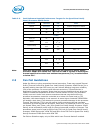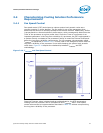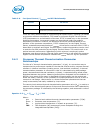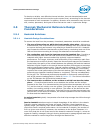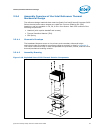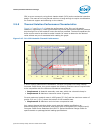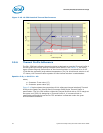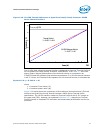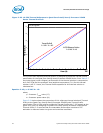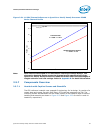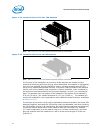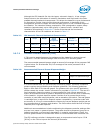
Thermal/Mechanical Reference Design
40 Quad-Core Intel® Xeon® Processor 5400 Series TMDG
The CEK reference thermal solution is designed to extend air-cooling capability through
the use of larger heatsinks with minimal airflow blockage and bypass. CEK retention
solution can allow the use of much heavier heatsink masses compared to the legacy
limits by using a load path directly attached to the chassis pan. The CEK spring on the
secondary side of the baseboard provides the necessary compressive load for the
thermal interface material. The baseboard is intended to be isolated such that the
dynamic loads from the heatsink are transferred to the chassis pan via the stiff screws
and standoffs. This reduces the risk of package pullout and solder-joint failures.
Using the CEK reference thermal solution, Intel recommends that the maximum
outside diameter dimension of the chassis pan standoffs, regardless of shape, that
interfaces with the CEK spring on the secondary side of the baseboard and captive
screws on the primary side of the baseboard to attach the heatsink to the chassis pan
should be no larger than 7.112 mm [0.28 in.]. For example, circular standoffs should
be no larger than 7.112 mm [0.28 in.] point-to-point.
The baseboard mounting holes for the CEK solution are at the same location as the hole
locations used for previous Intel
®
Xeon
®
processor thermal solution. However, CEK
assembly requires 10.16 mm [0.400 in.] large diameter holes to compensate for the
CEK spring embosses.
The CEK solution is designed and optimized for a baseboard thickness range of 1.57 –
2.31 mm [0.062-0.093 in]. While the same CEK spring can be used for this board
thickness range, the heatsink standoff height is different for a 1.57 mm [0.062 in] thick
board than it is for a 2.31 mm [0.093 in] thick board. In the heatsink assembly, the
standoff protrusion from the base of the heatsink needs to be 0.6 mm [0.024 in] longer
for a 2.31 mm [0.093 in] thick board, compared to a 1.57 mm [0.062 in] thick board.
If this solution is intended to be used on baseboards that fall outside of this range, then
some aspects of the design, including but not limited to the CEK spring design and the
standoff heights, may need to change. Therefore, system designers need to evaluate
the thermal performance and mechanical behavior of the CEK design on baseboards
with different thicknesses.
Refer to Appendix B for drawings of the heatsinks and CEK spring. The screws and
standoffs are standard components that are made captive to the heatsink for ease of
handling and assembly.
Contact your Intel field sales representative for an electronic version of mechanical and
thermal models of the CEK (Pro/Engineer*, IGES and Icepak*, Flotherm* formats).
Pro/Engineer, Icepak and Flotherm models are available on Intel Business Link (IBL).
Note: Intel reserves the right to make changes and modifications to the design as necessary.
Note: The thermal mechanical reference design for the Quad-Core Intel® Xeon® Processor
5400 Series was verified according to the Intel validation criteria given in Appendix E.1.
Any thermal mechanical design using some of the reference components in
combination with any other thermal mechanical solution needs to be fully validated
according to the customer criteria. Also, if customer thermal mechanical validation
criteria differ from the Intel criteria, the reference solution should be validated against
the customer criteria.
2.5.4.3 Structural Considerations of CEK
As Intel explores methods of keeping thermal solutions within the air-cooling space, the
mass of the thermal solutions is increasing. Due to the flexible nature (and associated
large deformation) of baseboard-only attachments, Intel reference solutions, such as



